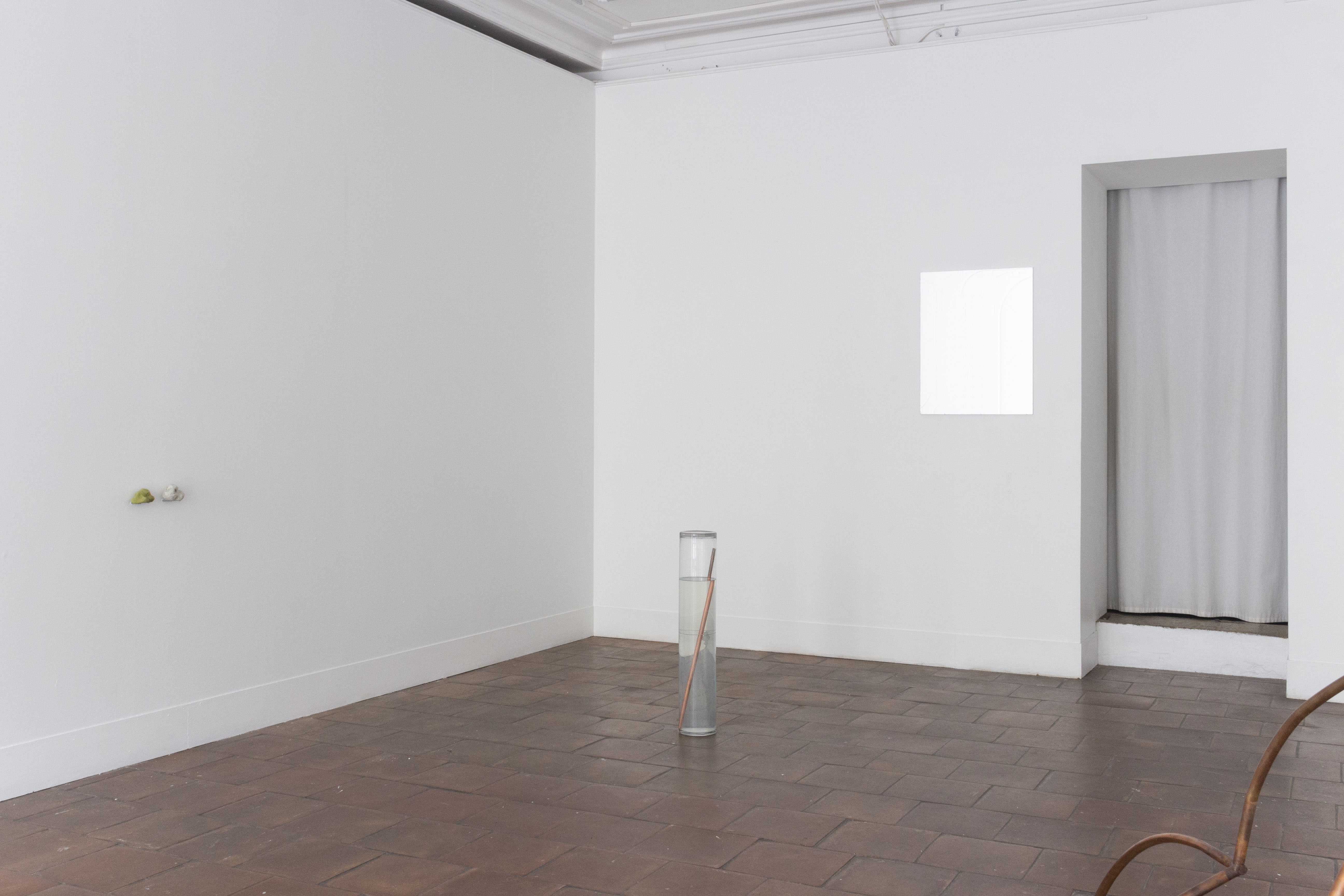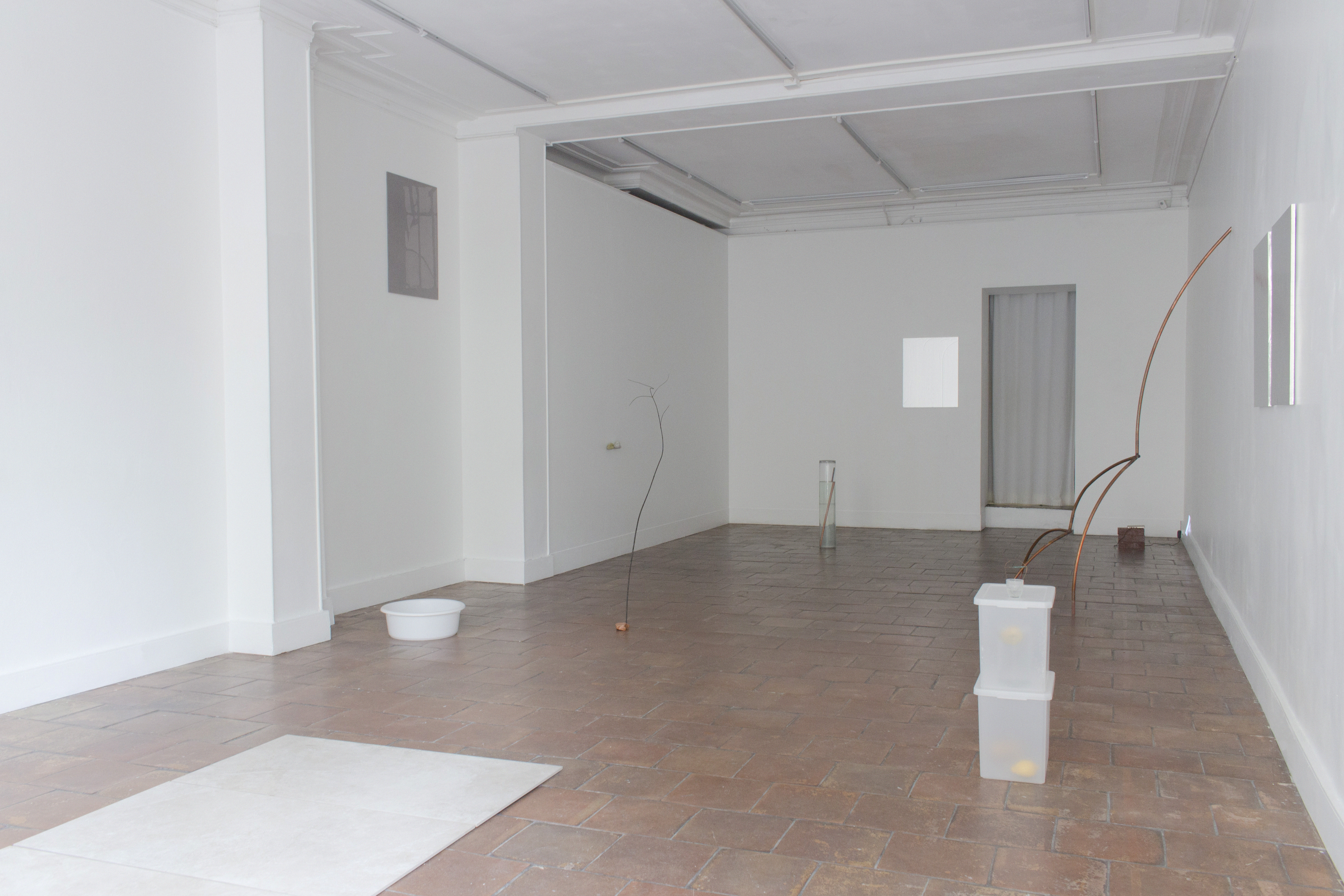Aléas circonstanciels, 2021
Exposition en duo avec Elisa Florimond à la galerie Mansart et proposée par Sarah Tritz.
Texte de Gabriela Anco :
“
Formes liquides, lumières pénétrant de l’intérieur des murs, vapeurs sur verre et arbres
poussant du sol jusque dans les murs : les œuvres de Noémie Pilo et Elisa Florimond sont une collection d’artefacts proposés comme preuves apparentes d’une recherche née
d’un questionnement constant, ainsi que d’une observation aiguë du monde. Comme une
intelligence artificielle ancestrale, les deux artistes dirigent leur visions tentaculaires et leurs
attention vers le monde qui les entoure, apprenant en voyant. Bien que différentes dans la
technique et la recherche, et sans être nécessairement complémentaires, les œuvres qui en
résultent exposent principalement des sensibilités uniques et personnelles dérivées d’un
monde observé sous la même perspective.
Percevant la nature aà la fois comme caractère et décorum, Elisa Florimond réinvente ses
formes à travers des corps métaphoriques. L’œuvre Pneumatophore montre une forme élégante
en tension perpétuelle. Equilibrant ses pieds fins sur le sol, elle est légèrement suspendue au
mur d’une manière à la fois fragile et cohérente. Comme une relique d’une mangrove, l’œuvre
rappelle au spectateur la force prodigieuse de ces arbres exhibant leurs racines et poussant
au-dessus de l’eau, en cycle constant avec la marée. Issus d’une réaction évolutive, ces arbres
nous rappellent le génie de la nature : adaptatifs, apprenants, s’auto-améliorant, rebondissant
de l’eau et pointant vers le ciel.
Une analogie indirecte peut être observée dans l’œuvre Chirales de Noémie Pilo, montrant
deux pierres. Alors que l’une des pierres conserve son état naturel, la seconde est recouverte
d’une teinte verte poudrée. En fait, l’œuvre s’inspire de la tradition japonaise du Suiseki qui
réside sur la recherche et la collecte de pierres expressives aux formes particulières. Les pierres
sont ensuite présentées sur des socles élaborés, mettant en avaant la culture de respect pour le
plus-que-humain, pour l’environnement, pour l’essentiel. L’acte de création est donc réservé àla Nature, et l’acte de l’exposition - aux humains. La couleur verte est quand à elle de la poudre de matcha, recouvrant la pierre comme si c’était
de la mousse, tout en faisant ressortir sa forme naturelle et évoquant encore une fois une
humidité invisible.
L’une des œuvres co-signées, Illusion naturelle, montre un tube de verre contenant une tige de
cuivre et un liquide de couleur bleuâtre qui, comme nous l’apprenons, est en fait un acide fort
conçu pour oxyder le cuivre et créer de la vapeur. La tension visuelle que produit cette œuvre
est renforcée par une fuite légère que l’on observe au sol et qui interroge la fermeture entre les
deux réceptacles. En effet, ils ne sont ni collés ni scellés et tiennent exclusivement à la tension
physique produite par le liquide et à l’équilibre précis de la répartition du poids entre les éléments.
Les lois de la chimie et de la physique sont approfondies en suite dans l’installation Arguments
ordinaires composée d’un petit verre tenant un fil de cuivre, posé sur le couvercle d’une de deux
boîtes en plastique contenant ce qui semble être des cruches et des citrons, comme un possible
hommage aux expositions Laboratory 02 (1996) d’Edith Dekyndt et Smog / Tomorrow’s Sculpture (2018) de Katinka Bock. Ces deux corpus d’œuvres représentent sans doute une inspiration
importante pour Elisa Florimond et Noémie Pilo, attirées par les éléments en constante évolution et les matériaux en mutation. A travers les murs de des boites de couleur laiteuse, le spectateur remarque que les citrons
flottent dans l’eau et que les boîtes quand à elles sont scellées. Comme l’œuvre précédente,
Arguments ordinaires évoque un changement et une transformation constants. Avec le temps,
les citrons se décomposent, provoquant une évaporation de l’eau plus rapide, dégageant de la
vapeur dans des endroits étranges. L’évolution de l’œuvre est encore inconnue et est à découvrir tout au long de l’exposition.
Cette fascinante exposition imprègne l’espace de couleurs claires et vaporeuses, exprimant une
sensibilité jeune et curieuse. Tout en même temps, la transformation constante des matériaux,
par fuite, évaporation, décomposition ou séchage, évoque inévitablement l’inquiétante étrangeté, le unheimlich, d’une vie à la fois déjà et pas encore vécue.”
-
Aléas circonstanciels, 2021
Duo show with Elisa Florimond at Galerie Mansart and proposed by Sarah Tritz.
Text by Gabriela Anco :
“Liquid forms, lights pouring from inside the walls, glass sweating and trees growing from
the ground and into the walls : the works of Noémie Pilo et Elisa Florimond are a collection
of artefacts seemingly proposed as proof of research born out of constant questioning and
observing of the world. As an early AI, the two artists aim their tentacular vision and attention
to the world around them, learning from seeing. Although different in both technique and
research, and rather than being complimentary, the resulting works are mainly expositing
unique and personal sensitivities derived from a world observed from them same perspective.
Perceiving nature at once as character and decorum, Elisa Florimond reinvents its forms
through metaphoric bodies. The work Pneumatophore shows an elegant shape in constant
tension. Balancing its narrow feet on the ground it hangs lightly from the wall in a way that
feels both fragile and consistent. As a relic from a mangrove, the work reminds the viewer of
the prodigious strength of these trees showing off their roots and growing above water and
in constant cycle with the tide. Morphed out of an evolutionary reaction these trees reming
us of the genius of nature: adaptive, learning, self-improving, rebounding from the water and
pointing towards the sky.
An indirect analogy can be observed in the work Chirales of Noémie Pilo, showing two stones.
Where as one of the stones maintains its natural state, the second one is covered in a green
powdery shade. In fact, the work is inspired by the Japanese tradition of Suiseki which is based
on finding and collecting expressive stones which have special shapes. The stones are then
displayed on elaborate plinths, inducing the culture of respect towards the more-than-human,
the environment, the essential. The act of creation is thus reserved for Nature, and the act of
display for the humans. The green colour is in fact matcha powder, discerning all the creases and the natural shape of
the stone, it covers it as if it was moss, evoking yet again an invisible humidity.
One of the co-signed works, Illusion naturelle, shows a glass tube containing a copper rod and a blueish coloured-liquid which as we learn is in fact a strong acid designed to oxidise copper
and create vapour. The visual tension this work produces is enhanced by a light leakage that
can be observed on the floor and which questions the closure in between the two receptacles.
In fact they are neither glued nor sealed and are holding exclusively on the physical tension
produced by the liquid and the precise balance of the distribution of weight among the
elements.
Laws of chemistry and physics are further explored in the installation Arguments ordinaires
consisting of a small glas holding a copper wire placed on top of two plastic boxes containing
what seem like water jugs and lemons, which come perhaps as an hommage to Edith
Dekyndt’s Laboratory 02 (1996) as well as to Katinka Bock’s Smog / Tomorrow’s Sculpture (2018)
exhibitions. Drawn to their ever-evolving elements and transforming materials, both bodies of
work represent great inspirations to Elisa Florimond and Noémie Pilo.
Through the milky walls the viewer notices that the lemons are floating in water and that the
boxes are sealed. As the previous work, Arguments ordinaires evokes a constant change and
transformation. With time, the lemons rot, causing the water to evaporate faster and build
vapour in odd places. The evolution of the work is yet unknown and is to be discovered throughout the exhibition.
This delightful exhibition permeates the space with light and vaporous colours, expressing a
young and curious sensitivity. All the while, the constant transformation of materials, through
leakage, evaporation, rotting or drying is inevitably summoning the unheimlich feeling of a life
both lived and not yet lived.”


